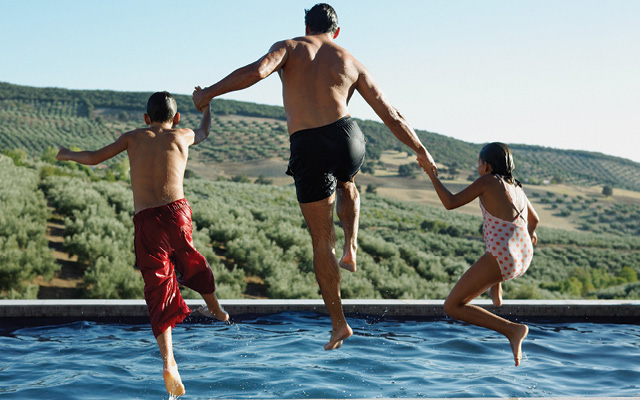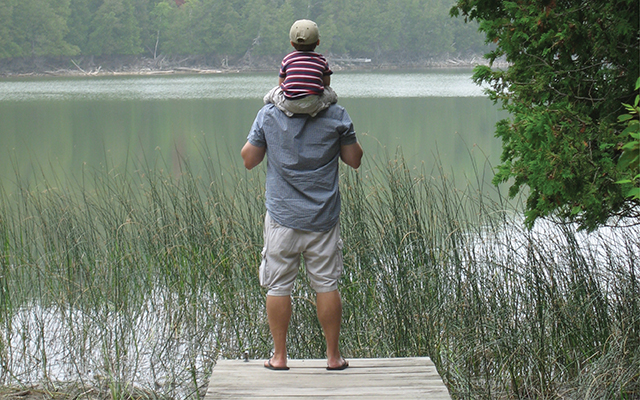For 11 months of the year, we daydream about where we’ll go on vacation — beaches, safaris, canyons — until we finally arrive at the week or two when we get to fulfill the dream. We return to work temporarily refreshed, only to spend another year anticipating.
The thing is, all that waiting to wind down isn’t necessary. Sure, long trips are great, but they’re not the only way to experience adventure or luxuriate in relaxation. Many experts believe that even a long weekend can deliver an impressive bang for your vacation buck. “If you have 12 vacation days, you’re better off planning a number of three- or four-day vacations per year than one long trip,” says Dan Buettner, author of Thrive: Finding Happiness the Blue Zones Way (National Geographic, 2010).
By studying populations worldwide, Buettner discovered that the healthiest, happiest people “downshift” routinely, not just annually. “Scheduling a string of downshifting vacations every other month helps you get into the routine of de-stressing your life.”
Science confirms that regular time off from work can reduce your chances of becoming ill or dying prematurely. But there’s another factor in the work-play equation: how long the good feelings last after you return from climbing in Yosemite or surfing in Hawaii.
The postholiday glow can fade with shocking speed, says vacation researcher Jessica de Bloom, MSc, of Radboud University Nijmegen in the Netherlands. In the people she studied, vacations’ aftereffects — less stress, fewer physical complaints — usually disappeared within the first week of their returning home. But more regular trips offer a greater number of relaxed, postvacation days.
Besides shortening the length of time between post-vacation highs (and lows), frequent three-day vacations give you more opportunities to visit a variety of locations with diversified experiences — a short winter ski adventure followed by summer cycling and fall mountaineering, for instance.
There’s also an enhanced happiness factor. “Much of our satisfaction from vacationing comes from planning a trip and remembering its highlights,” says Buettner. “If your life is punctuated with short vacations, then you’re getting more of those opportunities.”
Here are three examples of quick, no-fuss getaways: one restful and romantic, one high adventure, and one memorable trip of my own that combined them both. A key tip: Go somewhere that’s three hours or less from home. Shorter travel time helps make the most of a brief escape.
The Long-Weekend Retreat
When to go: Your nerves are frayed and you can’t switch out of work mode. You need R&R, ASAP, because you’re beginning to speak in acronyms.
As Troy and Linea Gagliano sipped wine and gazed through their hotel window, the Pacific tide crashed against the rocky coast of Yachats, Ore. “Watching the waves was a Zen moment that felt better than a Xanax,” says Linea, 40, a PR manager who was exhausted from juggling work and a baby. “I could feel the stress rolling off.”
For their three-day weekend, the Portland couple unplugged from their jobs and left the baby in his grandmother’s care. “We celebrated our independence by sleeping late and soaking in the Overleaf Lodge’s hot tub,” says Troy, 42, a renewable-energy developer. “We emphasized hedonism over exercise because our goal was to rest, reconnect and watch the mesmerizing waves.”
The couple did stretch their legs, exploring tidal pools filled with starfish and sea anemones. They kept their mini-vacation simple and unhurried by skipping an itinerary, ignoring the hotel-room TV and turning off cell phones. (Grandma had the lodge’s phone number in case of emergency.) They even packed picnic foods for the trip and ordered takeout so they could dine quietly in their room.
The getaway rejuvenated the Gaglianos’ relationship. “We had time to walk on the beach and laugh together,” says Linea. “After the trip, I was excited to see our boy, and I knew I could tackle work with a clearer vision. And I felt grateful for everything I have: a wonderful husband, a beautiful son and a great job.”
Planning tips:
- To save money, take restorative weekends in the off-season when the best hotel rooms are generally less expensive.
- If possible, choose a vacation spot that involves a scenic drive to get there. Then it feels like the holiday starts the moment you leave town.
The Active Adventure
When to go: You’ve been cooped up in the office and want to cut loose and challenge yourself with an invigorating physical escapade.
Russ Carroll and his son Nicholas, 12, of Weston, Mass., wanted to pump up their summer vacation. Traditionally, the family takes extended sightseeing trips in the car, but last year, Russ, 45, organized a guys-only three-day hiking trek in New Hampshire’s White Mountains. Not wanting to waste time with planning and logistics, Russ hired Appalachian Mountain Club (AMC) naturalist guides and invited some other family members to join them.
At the site, guides prepped the group on what to expect during three days of moderate-to-strenuous backpacking. That first day, as they summited Mt. Washington (New England’s highest peak and the site of numerous hiker fatalities), the wind blew 50 miles an hour and visibility was poor. “We felt safer with guides, knowing how easily we could have gotten lost or hurt in those conditions,” says Russ.
Wind-battered but triumphant, the group arrived at Lake of the Clouds Hut, where an AMC crew cooked a hearty dinner and showed them to one of several bunk rooms, which they shared with other hikers. There were no flush toilets or showers, but the hut was well equipped with food, water, pillows and blankets.
After breakfast, the group packed their lunches and headed out for another full day — this time in bright sunshine — to reach Mizpah Hut for their second night. They climbed more mountains, and the guides helped Nicholas use the GPS to locate a geocache treasure.
Physically reinvigorated, Russ felt like he’d been gone a month, not just four days. “I watched Nicholas’s confidence build as he made it over rough terrain carrying a 40-pound pack,” he says. “I saw him become responsible when he took a turn as our trail leader, even though he was the youngest. The change from hiking in nature was profound for all of us, from age 12 to 54.”
Another advantage of their short but rugged adventure: The brief time window allowed the Carrolls to go for broke on the trail, then return home rejuvenated — not exhausted.
Planning tips:
- No matter how brief your vacation, plan to spend some time in nature. It will get your head out of work mode and help stress evaporate more quickly.
- Hiring a guide for rugged trips helps keep you safe and saves you time on planning and logistics.
Yin and Yang Weekend
When to go: You and your travel companion have different fitness levels or enjoy different activities — or you simply yearn for some variety.
My first three-day vacation was inspired by the fact that I was recovering from knee surgery and wanted to join my husband on his annual ski trip. I don’t typically ski even when my knees are in top shape, but I was in desperate need of some restorative time away. So we opted for a trip to suit both our agendas: He skis, she spas.
We searched for a hotel that could accommodate our dual needs and found one just two hours from our Boulder home — at Devil’s Thumb Ranch Resort & Spa, in Tabernash, Colo. On 6,000 acres in the Rocky Mountains, the resort has a relaxing spa and yoga classes (for me), 65 adrenaline-packed miles of groomed Nordic ski and snowshoe trails (for him), and a fireplace in the room (for us).
On our first full day, Ken drove with his telemark skis to nearby Berthoud Pass, which straddles the Continental Divide, where the backcountry powder is deep. I threw a parka over my yoga attire and walked to the spa, where the yoga room has a view of snowy peaks. After class, it was time for my Altitude Adjustment, a treatment involving massage and hot towels soaked in relaxing lavender oil. Thoughts of writing deadlines evaporated.
Just before dusk, Ken returned, grinning like a skier who had been gliding through clouds. We celebrated our individual vacation experiences together in the hot tub under the stars before sharing a candlelight dinner.
Having multiple options ultimately benefited us both. On our last day, Ken indulged in some tension-loosening yoga with me before renting Nordic skis and blazing off on the Lazy Sunday Loop. We met for lunch, and then he decided to attempt a few laps of skate skiing. In the spirit of adventure, I strapped on snowshoes and tested my knee on an easy trail. I watched Ken skate the loop; he spotted me tramping through snow. We waved to each other and laughed. The future, I think, holds many more three-day vacations tailored for two.
Planning tips:
- When your trip involves a seasonal sport like skiing or golf, travel midweek to avoid weekend crowds.
- Find a hotel or resort that offers a smorgasbord of activities in one location.
3 Myths About Long Weekends, Debunked
Myth No. 1: Only long vacations are worth it.
Reality: If you take shorter vacations more often, you’re less likely to need extended downtime to regain balance. Think of a short vacation as a mini-correction to keep your life and health on the right track.
Myth No. 2: I’ll be tired when I get back.
Reality: If you let go of worries (and electronic gadgets) and commit to enjoying your vacation while you’re on it, you’ll return home refreshed. You might even find creative solutions to some of life’s problems while you’re away.
Myth No. 3: My work is too time-sensitive to unplug from the office for even three days.
Reality: If your three-day trip bridges a holiday weekend, you won’t miss any workdays at all. Even if it doesn’t, because the trip is brief, there’s far less catching up than after a longer vacation.




This Post Has 0 Comments